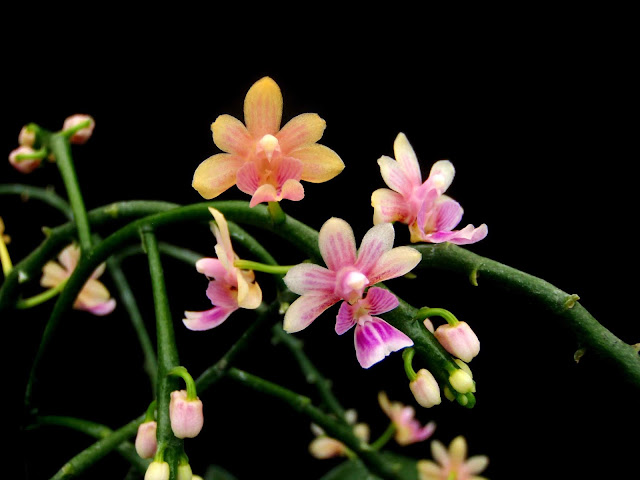Kingidium philippinense is not the same as Phalaenopsis deliciosa
Shown below is Kingidium philippinense, and below it, P. deliciosa. The immediately obvious difference between the rachises of both species is that it is branching on the former. Indeed, I am yet to see a flowering plant of P. deliciosa with branched inflorescences, whether live or in photos. Of course, there is that odd chance that someone is going to show me a photo or two of a deliciosa with branched inflorescence, but the two are separated more than by that character.
The lateral sepals of K. philippinense are oriented horizontally, while those of P. deliciosa are decidedly drooping. The labellum midlobe of K. philippinense is cuneate (wedge-shaped), but it is flabellate (fan-shaped) in P. deliciosa. The two-pronged callus have an extra tooth on each of the sides in K. philippinense, which is either lacking or rudimentary at the most in P. deliciosa. The markings of both taxa also differ, with those of K. philippinense being longitudinal stripes and those of P. deliciosa taking the form of tiny dots. I have seen a few photos of 'deliciosa' with striped perianths- and I say 'deliciosa' because of the habit of the lateral sepals- but it is possible that these plants are actually hybrids between the two. Such is the widespread belief that the two species are one and the same that it is not far-fetched to believe that inadvertent crossings have already been made. The foliage of the two taxa is different enough that even when not in flower, one can distinguish the two apart. The leaves of K. philippinense are dark green, with the new growths having undulate margins but straightening out as these mature. In P. deliciosa, the leaves are gray-green and the wavy margins often persist to maturity.
When I met Olaf Gruss in Singapore a few years ago we had a discussion about these plants, and he was also of the opinion that the two are readily separable by very apparent characteristics. I am myself puzzled as to why nobody else seems to notice these differences, which appear very consistent. Even in Co's Digital Flora of the Philippines, K. philippinense is treated as a synonym of P. deliciosa: http://philippineplants.org/Families/OrchidaceaeN-Z.html
 |
| Kingidium philippinense |
 |
| Phalaenopsis deliciosa |



Comments
Post a Comment